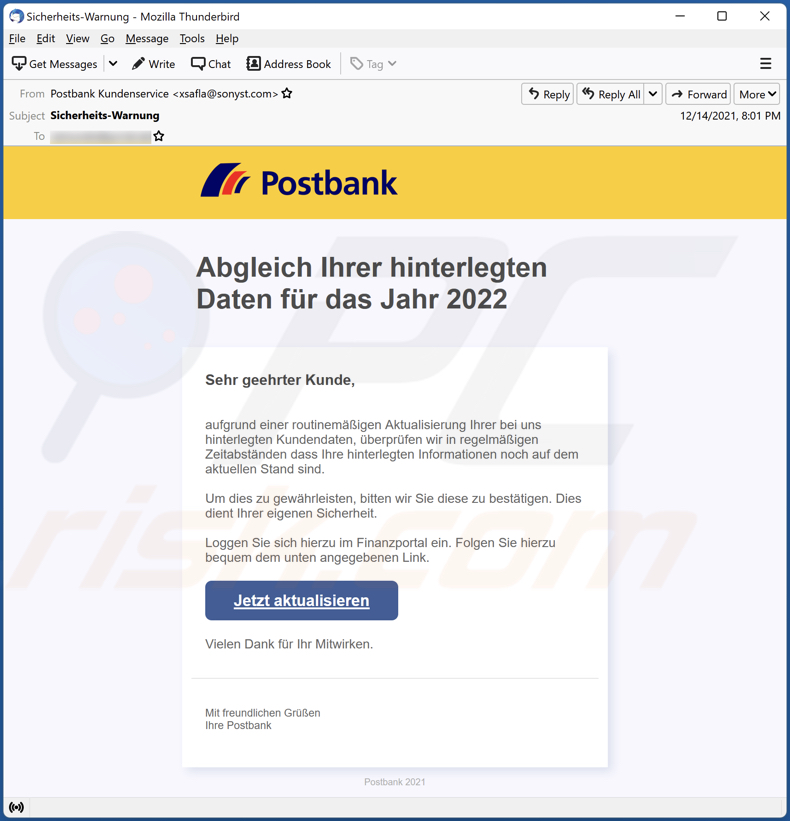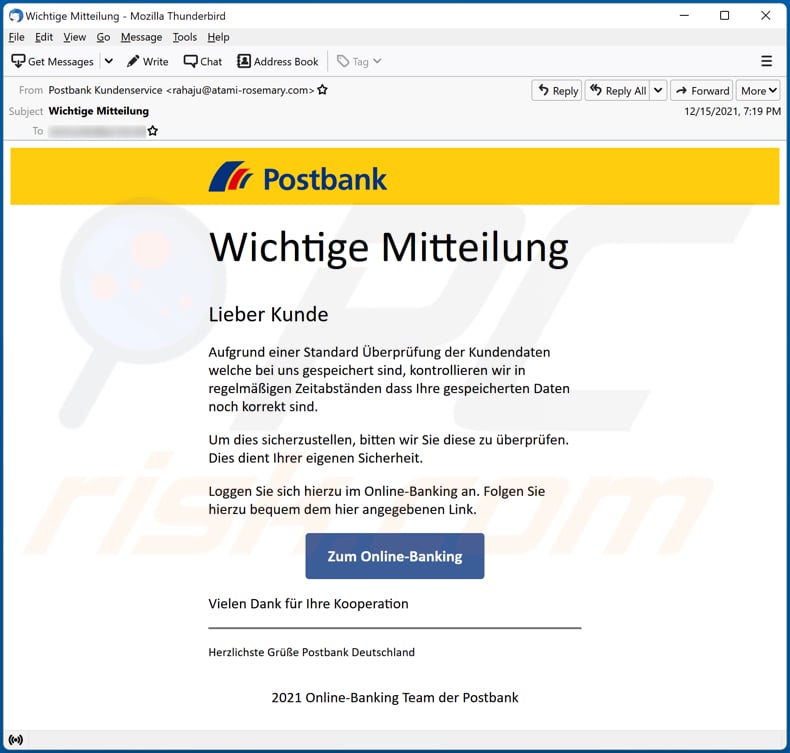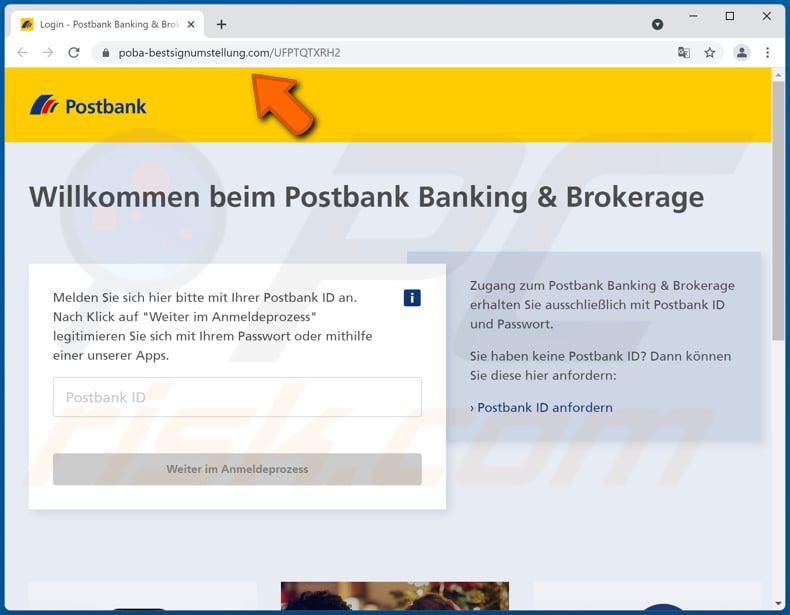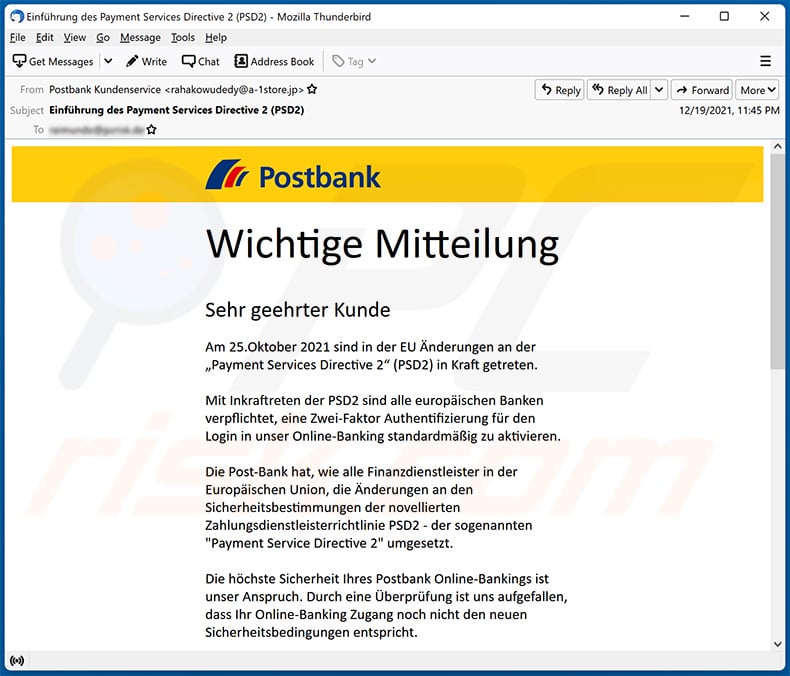How to recognize phishing emails like Postbank email scam?
Phishing/ScamAlso Known As: Postbank spam
Get free scan and check if your device is infected.
Remove it nowTo use full-featured product, you have to purchase a license for Combo Cleaner. Seven days free trial available. Combo Cleaner is owned and operated by RCS LT, the parent company of PCRisk.com.
What is Postbank email scam?
It is a phishing email targeting people who have Postbank (a legitimate retail banking company located in Germany) accounts. Scammers behind this email attempt to trick recipients into providing their Posbank ID and password. This email must be ignored.

Postbank phishing email in detail
The email is written in German. It claims that recipients are supposed to check whether the information provided on their Postbank online banking accounts is still correct. It encourages recipients to log into their accounts using the link that opens a fake Postbank login page. There are at least two variants of this email. Both of them are very similar.
| Name | Postbank Email Scam |
| Threat Type | Phishing, Scam, Social Engineering, Fraud |
| Fake Claim | Recipients are supposed to check their Postbank account information |
| Disguise | Letter from Postbank (a legitimate retail banking company) |
| Related Domain | poba-bestsignumstellung[.]com |
| Detection Names | Avira (Phishing), Combo Cleaner (Malware), CRDF (Malicious), Kaspersky (Phishing), Webroot (Malicious), Full List Of Detectios (VirusTotal) |
| Symptoms | Unauthorized online purchases, changed online account passwords, identity theft, illegal access of the computer. |
| Distribution methods | Deceptive emails, rogue online pop-up ads, search engine poisoning techniques, misspelled domains. |
| Damage | Loss of sensitive private information, monetary loss, identity theft. |
| Malware Removal (Windows) |
To eliminate possible malware infections, scan your computer with legitimate antivirus software. Our security researchers recommend using Combo Cleaner. Download Combo CleanerTo use full-featured product, you have to purchase a license for Combo Cleaner. 7 days free trial available. Combo Cleaner is owned and operated by RCS LT, the parent company of PCRisk.com. |
Phishing emails in general
As a rule, phishing emails are disguised as letters from legitimate companies or other institutions. They contain a link (or links) leading to a deceptive website where visitors are asked to provide sensitive information (usually, login credentials, credit card details).
More examples of similar scams are "ING Email Scam", "Volksbank Email Scam", "HostEurope Email Scam". Emails can also be used to trick users into infecting their computers with malware.
How do spam campaigns infect computers?
Cybercriminals send emails containing malicious links or attachments. Their goal is to trick recipients into downloading and then executing malicious files. Usually, they use MS Office, PDF documents, JavaScript files, archive files like RAR, ZIP, disc image files, or executable files for malware distribution.
Malicious MS Office documents cannot infect computers unless users enable editing/content (macros commands). It is because MS Office opens potentially malicious documents in Protected View mode. It is important to mention that MS Office versions released before 2010 do not include the mode mentioned above.
How to avoid installation of malware?
Do not click links or open files/attachments presented in irrelevant emails sent from unknown addresses. Use only official pages and legitimate platforms to download software (or files). Update and activate the installed software using tools provided by its official developer. Keep the operating system (and installed programs) up to date.
If you've already opened malicious attachments, we recommend running a scan with Combo Cleaner Antivirus for Windows to automatically eliminate infiltrated malware.
Text presented in the Postbank email scam (main variant):
Postbank
Wichtige Mitteilung
Lieber Kunde
Aufgrund einer Standard Überprüfung der Kundendaten welche bei uns gespeichert sind, kontrollieren wir in regelmäßigen Zeitabständen dass Ihre gespeicherten Daten noch korrekt sind.
Um dies sicherzustellen, bitten wir Sie diese zu überprüfen. Dies dient Ihrer eigenen Sicherheit.
Loggen Sie sich hierzu im Online-Banking an. Folgen Sie hierzu bequem dem hier angegebenen Link.
Zum Online-Banking
Vielen Dank für Ihre Kooperation
Herzlichste Grüße Postbank Deutschland
2021 Online-Banking Team der Postbank
Screenshot of the second email variant:

Text in this variant:
Postbank
Abgleich Ihrer hinterlegten Daten für das Jahr 2022
Sehr geehrter Kunde,aufgrund einer routinemäßigen Aktualisierung Ihrer bei uns hinterlegten Kundendaten, überprüfen wir in regelmäßigen Zeitabständen dass Ihre hinterlegten Informationen noch auf dem aktuellen Stand sind.
Um dies zu gewährleisten, bitten wir Sie diese zu bestätigen. Dies dient Ihrer eigenen Sicherheit.
Loggen Sie sich hierzu im Finanzportal ein. Folgen Sie hierzu bequem dem unten angegebenen Link.
Jetzt aktualisierenVielen Dank für Ihr Mitwirken.
Mit freundlichen Grüßen
Ihre Postbank
Postbank 2021
Screenshot of the fake Postbank login page:

Another example of Postbank-themed spam email:

Text presented within:
Subject: Einführung des Payment Services Directive 2 (PSD2)
Postbank
Wichtige Mitteilung
Sehr geehrter KundeAm 25.Oktober 2021 sind in der EU Änderungen an der „Payment Services Directive 2“ (PSD2) in Kraft getreten.
Mit Inkraftreten der PSD2 sind alle europäischen Banken verpflichtet, eine Zwei-Faktor Authentifizierung für den Login in unser Online-Banking standardmäßig zu aktivieren.
Die Post-Bank hat, wie alle Finanzdienstleister in der Europäischen Union, die Änderungen an den Sicherheitsbestimmungen der novellierten Zahlungsdienstleisterrichtlinie PSD2 - der sogenannten "Payment Service Directive 2" umgesetzt.
Die höchste Sicherheit Ihres Postbank Online-Bankings ist unser Anspruch. Durch eine Überprüfung ist uns aufgefallen, dass Ihr Online-Banking Zugang noch nicht den neuen Sicherheitsbedingungen entspricht.
Nur durch vollständige Umsetzung aller Maßnahmen kann die Postbank im neuen Jahr für noch mehr Sicherheit im digitalen Banking sorgen.
Um die geänderte PSD2 - der sogenannten "Payment Service Directive 2" vom 25. Oktober 2021 und die damit einhergehende noch sicherere Zwei-Faktor-Authentifizierung (2-FA) auch für ihr Postbank Login zu aktivieren, ist eine zusätzliche Überprüfung Ihrer Kundendaten und die Überprüfung durch einen Postbank Service-Mitarbeiter zwingend erforderlich.
Bitte beachten Sie, dass die Aktivierung bis zum 31.Dezember 2021 verpflichtend ist, da wir ansonsten den Login zu einschränken müssen.
Wir bitten Sie, die notwendigen Maßnahmen und den damit verbundenen Aufwand zu entschuldigen.
Aktivierung durchführen
Zu Ihrer Sicherheit haben wir auf die Angabe personenbezogener Daten in dieser E-Mail verzichtet.
Viele Grüße
Postbank Online-Team2021 Postbank Finanzportal
Instant automatic malware removal:
Manual threat removal might be a lengthy and complicated process that requires advanced IT skills. Combo Cleaner is a professional automatic malware removal tool that is recommended to get rid of malware. Download it by clicking the button below:
DOWNLOAD Combo CleanerBy downloading any software listed on this website you agree to our Privacy Policy and Terms of Use. To use full-featured product, you have to purchase a license for Combo Cleaner. 7 days free trial available. Combo Cleaner is owned and operated by RCS LT, the parent company of PCRisk.com.
Quick menu:
- What is Postbank spam?
- Types of malicious emails.
- How to spot a malicious email?
- What to do if you fell for an email scam?
Types of malicious emails:
![]() Phishing Emails
Phishing Emails
Most commonly, cybercriminals use deceptive emails to trick Internet users into giving away their sensitive private information, for example, login information for various online services, email accounts, or online banking information.
Such attacks are called phishing. In a phishing attack, cybercriminals usually send an email message with some popular service logo (for example, Microsoft, DHL, Amazon, Netflix), create urgency (wrong shipping address, expired password, etc.), and place a link which they hope their potential victims will click on.
After clicking the link presented in such email message, victims are redirected to a fake website that looks identical or extremely similar to the original one. Victims are then asked to enter their password, credit card details, or some other information that gets stolen by cybercriminals.
![]() Emails with Malicious Attachments
Emails with Malicious Attachments
Another popular attack vector is email spam with malicious attachments that infect users' computers with malware. Malicious attachments usually carry trojans that are capable of stealing passwords, banking information, and other sensitive information.
In such attacks, cybercriminals' main goal is to trick their potential victims into opening an infected email attachment. To achieve this goal, email messages usually talk about recently received invoices, faxes, or voice messages.
If a potential victim falls for the lure and opens the attachment, their computers get infected, and cybercriminals can collect a lot of sensitive information.
While it's a more complicated method to steal personal information (spam filters and antivirus programs usually detect such attempts), if successful, cybercriminals can get a much wider array of data and can collect information for a long period of time.
![]() Sextortion Emails
Sextortion Emails
This is a type of phishing. In this case, users receive an email claiming that a cybercriminal could access the webcam of the potential victim and has a video recording of one's masturbation.
To get rid of the video, victims are asked to pay a ransom (usually using Bitcoin or another cryptocurrency). Nevertheless, all of these claims are false - users who receive such emails should ignore and delete them.
How to spot a malicious email?
While cyber criminals try to make their lure emails look trustworthy, here are some things that you should look for when trying to spot a phishing email:
- Check the sender's ("from") email address: Hover your mouse over the "from" address and check if it's legitimate. For example, if you received an email from Microsoft, be sure to check if the email address is @microsoft.com and not something suspicious like @m1crosoft.com, @microsfot.com, @account-security-noreply.com, etc.
- Check for generic greetings: If the greeting in the email is "Dear user", "Dear @youremail.com", "Dear valued customer", this should raise suspiciousness. Most commonly, companies call you by your name. Lack of this information could signal a phishing attempt.
- Check the links in the email: Hover your mouse over the link presented in the email, if the link that appears seems suspicious, don't click it. For example, if you received an email from Microsoft and the link in the email shows that it will go to firebasestorage.googleapis.com/v0... you shouldn't trust it. It's best not to click any links in the emails but to visit the company website that sent you the email in the first place.
- Don't blindly trust email attachments: Most commonly, legitimate companies will ask you to log in to their website and to view any documents there; if you received an email with an attachment, it's a good idea to scan it with an antivirus application. Infected email attachments are a common attack vector used by cybercriminals.
To minimise the risk of opening phishing and malicious emails we recommend using Combo Cleaner Antivirus for Windows.
Example of a spam email:

What to do if you fell for an email scam?
- If you clicked on a link in a phishing email and entered your password - be sure to change your password as soon as possible. Usually, cybercriminals collect stolen credentials and then sell them to other groups that use them for malicious purposes. If you change your password in a timely manner, there's a chance that criminals won't have enough time to do any damage.
- If you entered your credit card information - contact your bank as soon as possible and explain the situation. There's a good chance that you will need to cancel your compromised credit card and get a new one.
- If you see any signs of identity theft - you should immediately contact the Federal Trade Commission. This institution will collect information about your situation and create a personal recovery plan.
- If you opened a malicious attachment - your computer is probably infected, you should scan it with a reputable antivirus application. For this purpose, we recommend using Combo Cleaner Antivirus for Windows.
- Help other Internet users - report phishing emails to Anti-Phishing Working Group, FBI’s Internet Crime Complaint Center, National Fraud Information Center and U.S. Department of Justice.
Frequently Asked Questions (FAQ)
Why did I receive this email?
Your email has likely been exposed in a data breach, and scammers used it to spread their scam. As a rule, phishing emails and other email scams are not personal.
I have provided my personal information when tricked by this email, what should I do?
If you have provided your Postbank account login credentials, then change all passwords and contact Postbank customer support immediately.
Can emails be used to deliver malware?
Yes, cybercriminals often use emails as a tools to distribute malicious software. These emails contain website links or attachments.
I have read the email but didn't open the attachment, is my computer infected?
No, opening an email by itself is harmless. Opening website links and opening attached files is what leads to computer infections.
Will Combo Cleaner remove malware infections that were present in email attachment?
Yes, Combo Cleaner can detect and eliminate almost all known malicious programs. It is recommended to scan the operating system using a full system scan. Otherwise, security software may not detect malware that could be hiding deep in the system.
Share:

Tomas Meskauskas
Expert security researcher, professional malware analyst
I am passionate about computer security and technology. I have an experience of over 10 years working in various companies related to computer technical issue solving and Internet security. I have been working as an author and editor for pcrisk.com since 2010. Follow me on Twitter and LinkedIn to stay informed about the latest online security threats.
PCrisk security portal is brought by a company RCS LT.
Joined forces of security researchers help educate computer users about the latest online security threats. More information about the company RCS LT.
Our malware removal guides are free. However, if you want to support us you can send us a donation.
DonatePCrisk security portal is brought by a company RCS LT.
Joined forces of security researchers help educate computer users about the latest online security threats. More information about the company RCS LT.
Our malware removal guides are free. However, if you want to support us you can send us a donation.
Donate
▼ Show Discussion